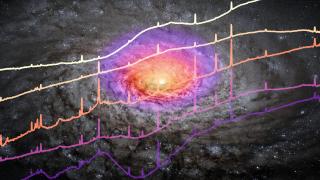Bibcode
Lopez-Rodriguez, E.; Packham, C.; Jones, T. J.; Siebenmorgen, R.; Roche, P. F.; Levenson, N. A.; Alonso-Herrero, A.; Perlman, E.; Ichikawa, K.; Ramos Almeida, C.; González-Martín, O.; Nikutta, R.; Martinez-Paredez, M.; Shenoy, D.; Gordon, M. S.; Telesco, C. M.
Referencia bibliográfica
Monthly Notices of the Royal Astronomical Society, vol. 464, issue 2, pp. 1762-1770
Fecha de publicación:
1
2017
Número de citas
11
Número de citas referidas
11
Descripción
We present high-angular (0.17$-$0.35 arcsec) resolution imaging
polarimetric observations of Mrk 231 in the 3.1 $\mu$m filter using
MMT-Pol on the 6.5-m MMT, and in the 8.7 $\mu$m, 10.3 $\mu$m, and 11.6
$\mu$m filters using CanariCam on the 10.4-m Gran Telescopio CANARIAS.
In combination with already published observations, we compile the
1$-$12 $\mu$m total and polarized nuclear spectral energy distribution
(SED). The total flux SED in the central 400 pc is explained as the
combination of 1) a hot (731 $\pm$ 4 K) dusty structure, directly
irradiated by the central engine, which is at 1.6 $\pm$ 0.1 pc away and
attributed to be in the pc-scale polar region, 2) an optically-thick,
smooth and disk-like dusty structure (`torus') with an inclination of 48
$\pm$ 23$^{\circ}$ surrounding the central engine, and 3) an
extinguished (A$_{\mbox{V}} =$ 36 $\pm$ 5 mag) starburst component. The
polarized SED decreases from 0.77 $\pm$ 0.14 per cent at 1.2 $\mu$m to
0.31 $\pm$ 0.15 per cent at 11.6 $\mu$m and follows a power-law
function, $\lambda^{\sim0.57}$. The polarization angle remains constant
($\sim$108$^{\circ}$) in the 1$-$12 $\mu$m wavelength range. The
dominant polarization mechanism is explained as scattering off hot dust
grains in the pc-scale polar regions.
Proyectos relacionados

Actividad Nuclear en Galaxias: una Perspectiva 3D del Núcleo y su Entorno
Nuestro proyecto puede dividirse en dos líneas principales de investigación. En primer lugar, el estudio de los vientos producidos por cuásares luminosos oscurecidos y del impacto que estos tienen en sus galaxias anfitrionas (retroalimentación del AGN). Para ello hemos obtenido observaciones en el óptico e infrarrojo cercano con el Gran Telescopio
Cristina
Ramos Almeida